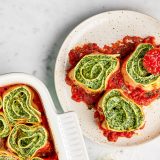When we try to recreate Italian recipes using supermarket-quality ricotta cheese, we always have the same problem—lackluster flavor and watery texture. That’s because most U.S. ricottas have a higher moisture content than Italian versions.
Traditionally, ricotta is made from whey, rather than milk. The whey is heated until the proteins form curds. But commercial U.S. ricotta is made from milk and is coagulated with additives, creating a more watery cheese. While some higher-end ricottas are strained, most supermarket versions aren’t. But that gave us an idea for how to handle the problem.
First, read the label. You want one that contains just milk and/or whey, salt and an acid. Avoid any with additives, stabilizers or preservatives. Next, strain it. Straining supermarket ricotta in a mesh strainer for 30 minutes, stirring occasionally, produced a cheese almost as good and dry as better brands, and it worked well in lasagna, stuffed shells and our Pasta Rotolo.
As we tested this, we tasted many brands. Our favorite was an artisanal variety by Bellwether Farms made from cultured milk and salt; it shed the least liquid. Meanwhile, Frigo ranked at the bottom, tasting sour and pasty and featuring various stabilizers.
For Better Ricotta, Break Out Your Strainer
For Better Ricotta, Break Out Your Strainer
Photo: Joe Murphy; Styling: Wes Martin







